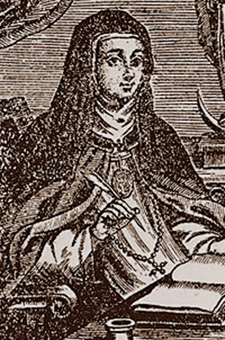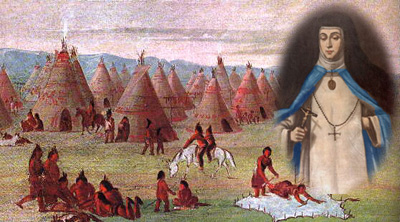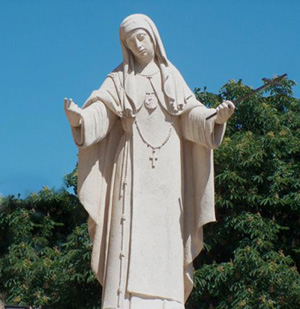 |
American History
Mary of Agreda in America - Part IV
Testimonies of Her Presence in the U.S.
Margaret C. Galitzin
In Part One on Ven. Mary of Agreda in America, we saw how the Jumano Indians in the Territory of New Mexico reported in 1630 that a Lady in Blue was visiting them and teaching them the Catholic Faith. The Indians described the woman in detail, and told the Franciscans at the Isleto mission outside Albuquerque that she had sent them to ask for Baptism. Two missionaries were sent on an exploratory mission to the Jumano camp (roughly 250-300 miles east of Santa Fe) and found the Jumanos and other surrounding tribes already knew the rudiments of the Faith. They all reported the same phenomena of a Lady in Blue who visited them.
Part Two explains how Fr. Alonso de Benevides, Inquisitor and the Superior of the New Mexico Colony, made a detailed report of the mission situation in 1630 – including an account of the Lady in Blue – and delivered it to the King of Spain and the Spanish Franciscan Superior. While there, he visited Mother Mary of Agreda in her convent.. After a careful investigation, he became convinced that she was the Lady in Blue. .
When Fathers Salas and Lopez left the Jumano camp in 1630, they evidently intended to return. The Indians realized that the fathers were making a preliminary inspection trip and did all they could to convince them to establish a permanent mission in Jumano territory. The decision, in fact, was in their favor, although the events turned out different from the plans.

A 17th century wood carving |
Spanish missionaries would minister to the Jumanos for the rest of the century, but not in the High Plains area. Soon after the first visit of the missionaries, the Jumanos, a nomadic hunter tribe, had to leave their customary hunting grounds.
It seems that, with the help of the Franciscans, they resettled in the Mission of the Immaculate Conception at Quarai in New Mexico, established in 1629-1630 (today known as Gran Quivira). In 1670 – some 40 years after the last documented visit of the Lady in Blue - at least part of the High Plains Jumanos were resettled in the Manso Mission founded by the Franciscans near El Paso in 1659.(1)
For the incredulous Europeans, Fr. Benavides’ Memorials of 1630 and 1633, valid historical records, would offer proof that the bilocations of Mother Mary of Agreda were not just fantastic legends of the superstitious ‘backward’ peoples.
For the Indians, the documentation was unnecessary. From one generation to another, the stories of the Conceptionist nun in her blue cape were recounted, evidence of her miraculous visits preserved by word of mouth, an enduring oral history.
“I want no other color but blue”
Fr. Benavides’ Memorials are not, however, the only documented evidence of Mother Mary of Agreda’s presence in the New World. As other Spaniards came to the territory where Mary of Agreda had made her visits, they found Indians who remembered a Lady in Blue and her teachings of the doctrine of Jesus Christ.
In 1689, 24 years after the death of Mary of Jesus, Spanish explorer Alonso de Leon made his fourth expedition into Texas territory. In his letter to the Viceroy, a report giving a detailed record of the expedition, (2) he wrote that some of the Tejas Indians whom he met were already partly instructed in the Catholic Faith because of the visits of the Lady in Blue to their forefathers. These are his words:
“They perform many Christian rites, and the Indian chief asked for missionaries to instruct them, saying that many years ago a woman went inland to instruct them, but that she had not been there for a long time.” (3)

Indians recount stories of a lady in blue visiting their forefathers |
Franciscan Fr. Damian Massanet accompanied de Leon on this expedition. Two years earlier, he had established Mission San Francisco de los Tejas, the first mission in East Texas. In a report to the Viceroy, he tells of an incident that took place on this expedition among the Tejas Indians.
The expedition leaders were distributing clothing to the Indians. Their chief, or “governor”, as Fr. Massanet called him, asked for a piece of blue baize for a shroud to bury his mother in when she died. Fr. Massanet writes:
“I told him that cloth would be better, and he said that he did not want any other color than blue. I asked then what mystery was attached to the color blue, and the governor said that they were very fond of blue, particularly for burial clothes, because in times past a very beautiful woman visited them there, who descended from the heights, and that this woman was dressed in blue and that they wished to be like her.
“Being asked whether that was long ago, the chief said that it had not been in his time, but that his mother, who was aged, had seen her, as had the other old people. From this it is seen clearly that it was Mother Maria de Jesus de Agreda, who was very frequently in those regions, as she herself acknowledged to the Father Superior in New Mexico.” (4)
Arizona Indians recall stories of a beautiful woman
Another written testimony to the presence of Mary of Agreda among the Indians of Arizona comes from the record book of Captain Mateo Mange, who traveled with Jesuit priests Eusebio Francisco Kino and Adamo Gil on the expedition to discover the Colorado and Zila Rivers in 1699.
Once, when speaking with some very old Indians, the explorers asked them if they had ever heard their elders speak about a Spanish captain passing through their region with horses and soldiers. They were seeking information about the expedition of Don Juan de Oñate in 1606.
The Indians told them that they could remember hearing of such a group from the old people who were already dead. Then they added - without any question to prompt them - that when they were children a beautiful white woman, dressed in white, brown and blue, with a cloth covering her head, had come to their land.

A lady with a cross who "descended from above" to teach the Indians |
Mange recounts more of what the Indians told him:
“She had spoken, shouted and harangued them … and showed them a cross. The nations of the Colorado River shot her with arrows, leaving her for dead on two occasions. Reviving, she disappeared into the air. They did not know where her house and dwelling was. After a few days, she returned again and then many times after to preach to them.” (5)
This would concur with the report of Fr. Benevides, who had interviewed Mother Mary of Agreda in her convent see Part II. She told him that on several occasions the Indians had turned on her and shot arrows at her, leaving her for dead. She felt the pain of the attacks, but when she would come to herself later in the convent in Agreda, there was no sign of the wounds.
Mange further notes that the Indians of San Marcelo had told them this same story five days earlier, although at that time they had not believed it. But the fact that they heard the same thing repeated in a place some distance away made them begin to suspect that the woman was Mother Mary of Jesus of Agreda. The missionaries were acquainted with her life and work, and knew from Fr. Benavides’ Memorials that during the years 1620-1631 she had preached to the Indians of North America. (6)
Almost 70 years had passed since that time, and these old men – who appeared to be about 80 – would have been young boys at the time that the Lady in Blue visited them.
The legend of the bluebonnet
Historical documents clearly indicate Mary of Agreda visited the Southwest United States many times in the 1620s to instruct the Indians. It is not a legend.

The blue flowers commemorated the visits of Mary of Agreda |
Fr. Benavides, a trusted Inquisitor, left Agreda convinced that Mary of Agreda had been physically present in the New World, and that her visits had continued until the same year, 1631. In 1635 he became the Bishop of Goa, and he always recommended himself to the prayers of the Conceptionist Abbess and maintained the highest esteem for her.
There was, however, one charming legend that sprung up among the Tejas Indians, inspired by their love and respect for the Lady in Blue.
According to it, after the Franciscans came to baptize and catechize the people, the Lady in Blue told the Jumanos that her visits were at an end. When she mysteriously left them in her accustomed way, the hillside where she had appeared was blanketed with beautiful blue flowers, a memory of her presence among them. That flower came to be known as the Bluebonnet, today the state flower of Texas.
1. Nancy P. Hickerson, "The Visits of the 'Lady in Blue': An Episode in the History of the South Plains, 1629" Journal of Anthropological Research, Vol. 46, No. 1 (Spring, 1990), pp. 67-90; http://www.jstor.org/stable/3630394
2. Damian Massanet, Letter of Fray Damian Massanet to Don Carlos de Siguënza, in Bolton, Herbert Eugene Bolton (ed.), Spanish Exploration in the Southwest, 1542-1706 (New York: Charles Scribner's Sons, 1916). Pp. 347-38; www.americanjourneys.org/aj-018/
3. W. Donahue, “Mary of Agreda and the Southwest United States,” p. 310; see Article 1, Note 1).
4. Idem, in Ibid., p. 310
5. Ibid., p. 311
6. Ibid.
Continued

Posted March 8, 2010

Related Topics of Interest
 Mary of Agreda in America - Part I Mary of Agreda in America - Part I
 Mary of Agreda Describes Her Travels - Part II Mary of Agreda Describes Her Travels - Part II
 Catholicism in Colonial America Catholicism in Colonial America
 La Conquistadora: Our Country's Oldest Madonna La Conquistadora: Our Country's Oldest Madonna
 Ven. Antonio Margil of Jesus: Apostle of New Spain Ven. Antonio Margil of Jesus: Apostle of New Spain
 The First Expedition into the American Southwest The First Expedition into the American Southwest
 Pasquala of Mission Santa Ines Pasquala of Mission Santa Ines

Related Works of Interest
|
|
History | Home | Books | CDs | Search | Contact Us | Donate

© 2002-
Tradition in Action, Inc. All Rights Reserved
|
 |
|